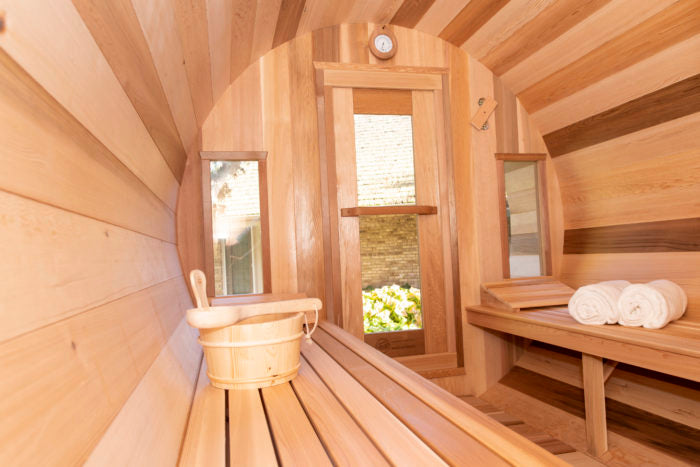Traditional Sauna Things To Know Before You Buy
Traditional Sauna Things To Know Before You Buy
Blog Article
What Does Traditional Sauna Do?
Table of ContentsSome Known Details About Traditional Sauna The 6-Minute Rule for Traditional SaunaEverything about Traditional SaunaTop Guidelines Of Traditional SaunaThe 25-Second Trick For Traditional Sauna
Power financial savings is one point to think about for people who plan on using their sauna regularly. For a conventional sauna, bathers normally require to await 30-40 mins for the room to pre-heat prior to getting in. Infrared saunas, on the other hand, commonly reach their excellent temperature in around 15 minutes.That suggests that in an infrared sauna, bathers can start appreciating their sauna right away. One difference in between the two types of sauna that is usually ignored is the social experience.

Attempt a sauna today and uncover several of the amazing advantages on your own!.
Our Traditional Sauna Ideas

Elements such as heat resistance, desired degree of detoxification, and overall wellness ought to be thought about when deciding which sort of sauna to utilize (Traditional Sauna). Infrared saunas are a kind of sauna that utilize infrared light to heat the body directly, rather than heating the air around the body like standard saunas

The temperature in an infrared sauna is normally less than in a conventional sauna, with temperature levels ranging from 120F to 150F. Infrared saunas provide a variety of advantages that make them an eye-catching option for those wanting to enhance their health and well-being. Several of the benefits of infrared saunas include: Infrared saunas use reduced temperature levels than standard saunas, which can make them extra comfy for those that discover high temperature levels hard to tolerate.
Traditional Sauna for Beginners

The warmth generated by infrared saunas can assist to enhance blood circulation and enhance circulation. Infrared saunas have been revealed to aid decrease anxiety and advertise relaxation.
With their lower useful link temperatures, deep infiltration, and variety of wellness advantages, infrared saunas are a great means to loosen up, loosen up, and enhance your overall wellness. Standard dry saunas have been around for centuries and are still preferred today. They are commonly heated up with wood, gas, or electrical energy and have low moisture degrees.
Some Known Details About Traditional Sauna
There are several benefits to making use of a standard dry sauna. Below are a few: Leisure: The heat and low moisture in conventional completely dry saunas can help kick back the muscles and minimize stress and anxiety levels. Detoxing: Sweating in a sauna can help get rid of contaminants from the body, which can enhance total health and wellness.
When it comes to saunas, there image source are two major kinds of heating approaches: traditional and infrared. Standard saunas use heated air to heat the body, while infrared saunas make use of infrared radiation to penetrate the skin web link and warm the body from within. Among the major differences in between the 2 methods is the sort of warm they generate.
Because infrared radiation permeates the skin a lot more deeply, it can create a comparable sweat response at lower temperatures. One more distinction is the method the warm is dispersed. Standard saunas warm the air, which then heats up the body with convection. Infrared saunas, on the other hand, warm the body directly with radiation.
In regards to energy performance, infrared saunas are usually extra efficient than traditional saunas because they require less power to run. They likewise warm up a lot more swiftly, so they can be utilized for shorter sessions. When it concerns the effects on the body, both sorts of saunas have been shown to have advantages.
An Unbiased View of Traditional Sauna
Infrared saunas have been revealed to have comparable benefits, as well as possibly assisting with detoxification, skin wellness, and immune function. Overall, the choice in between a standard or infrared sauna comes down to individual preference and specific needs. Standard saunas may be much better for those who like higher temperature levels and a more extreme sweat feedback, while infrared saunas may be much better for those who desire a more gentle and reliable warm therapy.
Both kinds of saunas offer one-of-a-kind benefits and downsides that need to be taken into consideration before deciding. The choice in between an infrared sauna and a conventional completely dry sauna mainly depends on individual preference and the wanted advantages. Those that prefer an even more comfy, reduced temperature level setting might favor an infrared sauna, while those who are seeking intense heat and a typical sauna experience might favor a typical completely dry sauna.
Below are some safety and security tips to remember when using infrared and conventional dry saunas:: Saunas can create extreme sweating, causing dehydration. It is crucial to consume plenty of water before, during, and after sauna sessions to remain hydrated.: It is advised to limit sauna sessions to 20-30 minutes to prevent overheating and dehydration.
Report this page